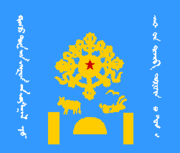
Tuvan People's Revolutionary Party
Encyclopedia

Political party
A political party is a political organization that typically seeks to influence government policy, usually by nominating their own candidates and trying to seat them in political office. Parties participate in electoral campaigns, educational outreach or protest actions...
in Tuva
Tuva
The Tyva Republic , or Tuva , is a federal subject of Russia . It lies in the geographical center of Asia, in southern Siberia. The republic borders with the Altai Republic, the Republic of Khakassia, Krasnoyarsk Krai, Irkutsk Oblast, and the Republic of Buryatia in Russia and with Mongolia to the...
, founded in 1921. When the Tuvinian People's Republic
Tuvinian People's Republic
The Tuvan People's Republic was an independent state in the territory of the former Tuvan protectorate of Imperial Russia , also known as Uryankhaisky Krai . It was a satellite state of USSR...
was founded in the same year, the party held single-party control over its government as a vanguard party
Vanguard party
A vanguard party is a political party at the forefront of a mass action, movement, or revolution. The idea of a vanguard party has its origins in the Communist Manifesto by Karl Marx and Friedrich Engels...
.
History
Under Soviet sponsorship, a conference of Tuvinian revolutionaries convened on October 29, 1921, and an organization bureau was formed. The first Congress met on February 28, 1922, when the Tuvinian "People's Government" was established. However, as soon as the Second Congress convened on July 6, 1923, the former party was dissolved because of Soviet dissatisfaction, and a new one was organized. The Fourth Congress met in October, 1925; the Seventh Congress, in 1928. The Central Committee was authorized to establish party cells and branches of the league of revolutionary youth throughout the country.During the Second Plenary Session of the Central Committee of the party in 1929 the right-wing leadership, which had intended to retain Lamaism as a state religion in the old sense, in contradiction to the proclaimed constitution, was completely destroyed. Under the watchword of "antifeudal revolution," the Eighth Congress paved the way for socialist reconstruction and collectivization. When, in April–May, 1930, the so-called "counterrevolution of the Tuvinian nobles and the Russian kulak-colonists" broke out with the intent "to overthrow the 'Revolutionary Government,'" it was also put down by force. Resolutions were adopted in the Central Committee of the People's Revolutionary Party to confiscate the property of the exploiter class, to conduct agricultural collectivization "on an unconditionally voluntary basis," "to struggle for complete independence from the imperialist countries and to co-operate closely with the oppressed peoples and the working class of the whole world."
A prominent figure in its initial stage was Donduk Kuular
Donduk Kuular
Donduk Kuular was a Tuvan monk, politician, and first prime minister of the Tuvinian People's Republic.Donduk was originally a Lamaist monk. As leader of a group of Russian-supported Bolsheviks, he proclaimed the independence of the People's Republic of Tannu Tuva, in 1921. He subsequently...
. In 1929-1932 a political shifted occurred, as nationalist elements of the party, including Kuular, were purged. The leadership of the party was taken over by Salchak Toka
Salchak Toka
Salchak Kalbakkhorekovich Toka was a Tuvan politician. He was for many years the communist ruler of Tuva, and as well the Second Prime Minister of the Tuvan People's Republic....
.
The party was admitted to the Comintern
Comintern
The Communist International, abbreviated as Comintern, also known as the Third International, was an international communist organization initiated in Moscow during March 1919...
as a "sympathizing party" at its Seventh Congress in 1935.

